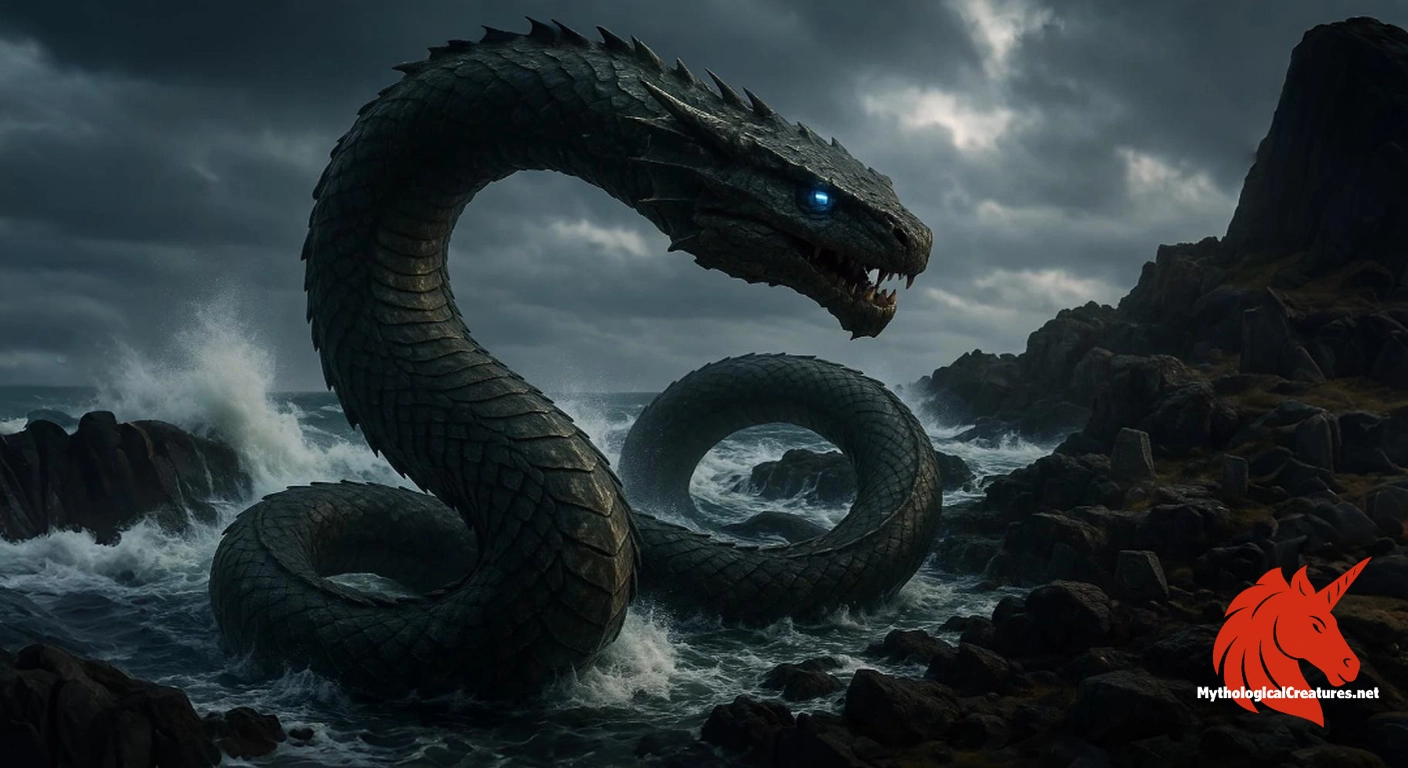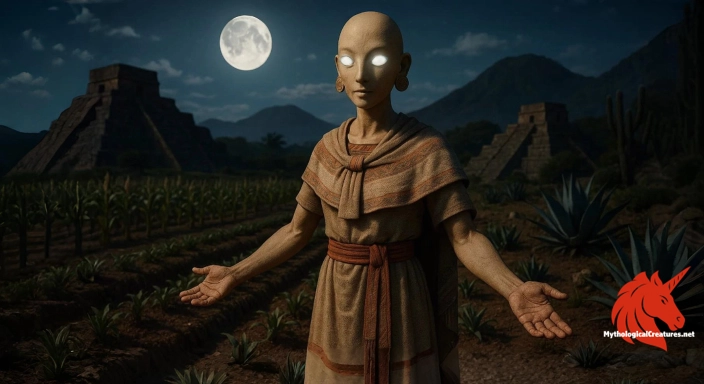Jörmungandr: Jörmungandr, the Midgard Serpent, is an enormous sea serpent in Norse mythology that encircles Midgard and bites its own tail.

Jörmungandr
Jörmungandr - Represents the inevitable cycle of destruction and rebirth in Norse cosmology and plays a central role in the apocalyptic myth of Ragnarök.
Origins & First Encounters
Jörmungandr stands as one of Norse mythology’s most formidable and enigmatic figures, a colossal sea serpent whose legend bridges the realms of gods and the primordial deep. Born of the trickster deity Loki and the giantess Angrboða, his origin is steeped in the rich and turbulent mythic traditions of the North. The earliest accounts, notably found in the Prose Edda, reveal a creature whose destiny is intertwined with the cosmic cycle of creation and destruction. His immense form is said to encircle Midgard, the world inhabited by humankind, binding the earthly domain with the abyss beyond. As the symbol of an endless cycle, his image of biting his own tail conveys both infinity and self-renewal. The narrative of Jörmungandr is not only a tale of monstrous growth but also a portent of Ragnarök, the prophesied end of the world. His story contextualises the tension between order and chaos, a core element of Norse cosmology. In cultural terms, he has become an enduring emblem of the raw and unbridled forces that shape both the natural and spiritual realms.
Source Texts & Tale Variants
The accounts of Jörmungandr are primarily found within the corpus of medieval Norse literature, with the Prose Edda offering the most detailed narrative of his origin and fate. His presence also echoes through fragments of the Poetic Edda, where hints of his massive form and duelling destiny with Thor are interwoven with the larger mythic tapestry. Variations in the stories highlight his central role in the foretelling of Ragnarök and the cosmic battles that define the Norse eschatology. While early texts focus on his birth and apocalyptic significance, later oral traditions embellish his exploits with vivid descriptions and symbolic nuance. Subtle differences in detail among the various sources demonstrate how oral storytelling adapted his character to reflect regional sensibilities. Some versions stress his monstrous, otherworldly nature, while others suggest a deeper cosmological significance behind his eternal cycle. The diverse retellings ensure that his legend remains multifaceted, with each source contributing to the broader understanding of his role in the mythology. Over time, these narratives have woven together a complex portrait of a creature that is as much a force of nature as he is a mythic antagonist.
Form & Powers
Jörmungandr is visualised as an immensely long and sinuous beast whose physical presence overwhelms the imagination. His body, covered in a labyrinth of dark, interlocking scales, flows like the depths of a stormy ocean. Depictions often emphasise his colossal size, suggesting that his form is so vast it spans the world, encapsulating both the horizon and the abyss. His head, replete with fierce eyes and heavy jaws, manifests a menacing character that warns of impending doom. The image of him biting his own tail, a classic ouroboros, encapsulates the eternal cycle of regeneration and decay. Various accounts portray his scales with an almost luminescent quality, as if they reflect both the light of the sun and the depths of the sea. Artists throughout the ages have taken creative licence with his depiction, sometimes enhancing his form with mystical and almost otherworldly embellishments. Even in varied artistic interpretations, the intrinsic link between his physical form and the vast, unknowable forces of nature remains consistently powerful.
Regional Faces
The myth of Jörmungandr has transcended its original Norse narrative, finding varied expressions across different Scandinavian regions. In Iceland, where the raw power of the ocean is a constant presence, the serpent is often portrayed with an accentuated sense of mystery and forewarning. Northern coastal traditions incorporate local maritime superstitions, imbuing his legend with an aura that is both protective and ominous. In Denmark and Sweden, adaptations of his story occasionally merge with local sea monster myths that served as warnings to seafarers. These regional versions may alter his size, colouring, or even the symbolic implications of his form to better resonate with the surrounding landscape and experiences. Folk traditions sometimes depict him as a guardian of underwater treasures or as a signifier of tumultuous weather, reflecting the deep connection between local communities and the volatile sea. Such adaptations ensure that his mythic presence remains intimately tied to the lived reality of the people who inhabit these regions. In each locale, while the core elements of his legend endure, the nuances of his interpretation reveal the adaptability and continuing relevance of his myth.
Cultural Parallels
Across the mythological spectrum, Jörmungandr finds fascinating parallels with other legendary serpents and creatures symbolising cyclical renewal. His self-consuming tail reflects the ancient symbol of the Ouroboros, a motif present in Egyptian, Greek, and early alchemical traditions as a representation of eternal life and rebirth. Comparisons are often drawn between him and the biblical Leviathan, both embodiments of chaos and the uncontrollable forces of nature. Like many serpentine deities found in various cultures, his role straddles the line between creation and destruction, highlighting a dual nature that is both terrifying and essential. Similar archetypal creatures surface in Eastern mythologies, where dragons and serpents represent pivotal natural and cosmic cycles. The underlying themes of transformation, apocalyptic foresight, and an eternal return resonate across these diverse cultural narratives. Through this cross-cultural lens, Jörmungandr emerges as a compelling symbol of nature’s dynamic balance between order and chaos. Such comparative perspectives enrich our understanding of how ancient societies personified the most profound and enigmatic forces of the world. His myth thus contributes to a broader dialogue about the universal human fascination with the cyclical patterns of existence.
Legacy & Modern Evolution
Over the centuries, the legend of Jörmungandr has evolved from its medieval roots into a symbol that continues to captivate modern audiences. Initially depicted as an ominous harbinger of Ragnarök, his image was central to the apocalyptic visions of early Norse literature. In more recent times, his myth has been revitalised through literature, cinema, and digital media, where he is often reinterpreted as both a destructive force and an emblem of natural cyclicality. Contemporary portrayals tend to highlight his complex role, balancing the notions of environmental chaos with themes of renewal and transformation. This evolution reflects a shift in cultural perceptions, where the serpent’s apocalyptic nature is increasingly seen as part of a broader narrative of ecological interconnectedness. Modern artistic and narrative experiments have melded traditional imagery with current environmental and existential concerns. His enduring appeal is also evident in fantasy genres, where he often appears in reimagined battles with gods, particularly with Thor as his perennial adversary. As a result, Jörmungandr has transitioned into a versatile symbol, encapsulating both the ancient fears of cosmic disruption and a modern reverence for nature’s cyclical power. His legacy remains a vivid testament to the ability of myth to adapt and thrive across the epochs.
Interesting Fact
Jörmungandr's ouroboros form has transcended its mythological origins, becoming a potent symbol of cyclicality and eternal return in various cultural and philosophical contexts.
Quick Creature Info
Type:
Origin:
Features:
Associations:
Our Mythic Legendary Rating:

Also Sometimes Known As:
Habitat:
Supernatural Powers:
Physical Attributes:
Abilities:
Behavior:
Weaknesses:
Lore:
Related Creatures, Tales or Lore
References
Discover Another Mythical Legend You May Not Have Heard Of?
Uncover the mysteries of ancient folklore and expand your knowledge of legendary beings from cultures around the world.
Dare to Meet the Metztli....
Mythical Disclaimer: The images and data on this site are derived from various historical and literary sources, but we have found that many myths often have multiple versions and interpretations across references, sometimes contradictory. As a result, these creature depictions are artistic interpretations—imaginative blends of folklore, legend, and a dash of AI guesswork. Because creature descriptions vary widely, our illustrations and accompanying information represent our best effort to honor mythology while bridging creative gaps. Enjoy these interpretations—just remember, we've done our best to respect the stories and validate available data, but in the realm of mythology, details often shift, imagination leads the way, and nothing is ever set in stone!
Curated by the Mythological Creatures Team (rev. May 2025)
